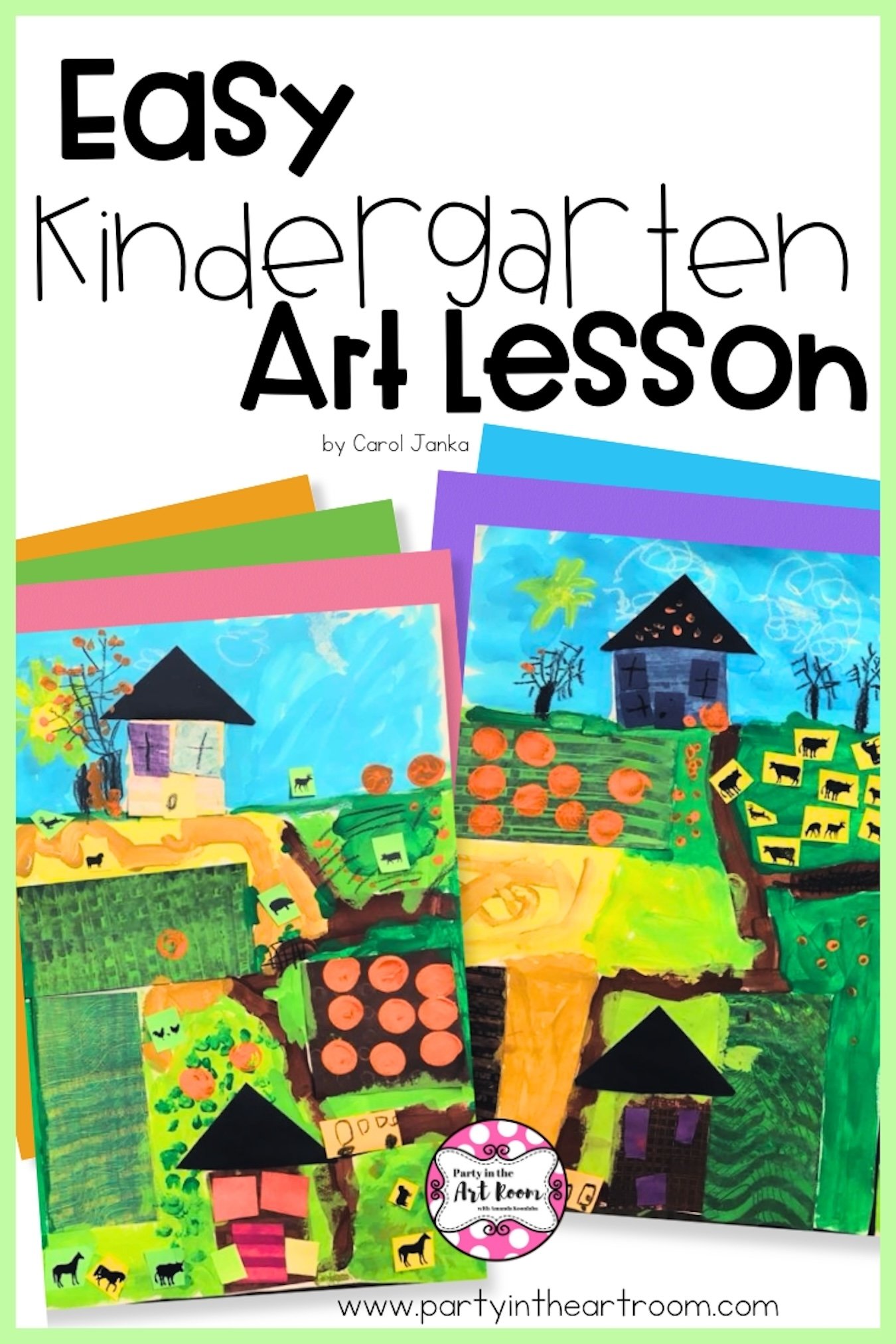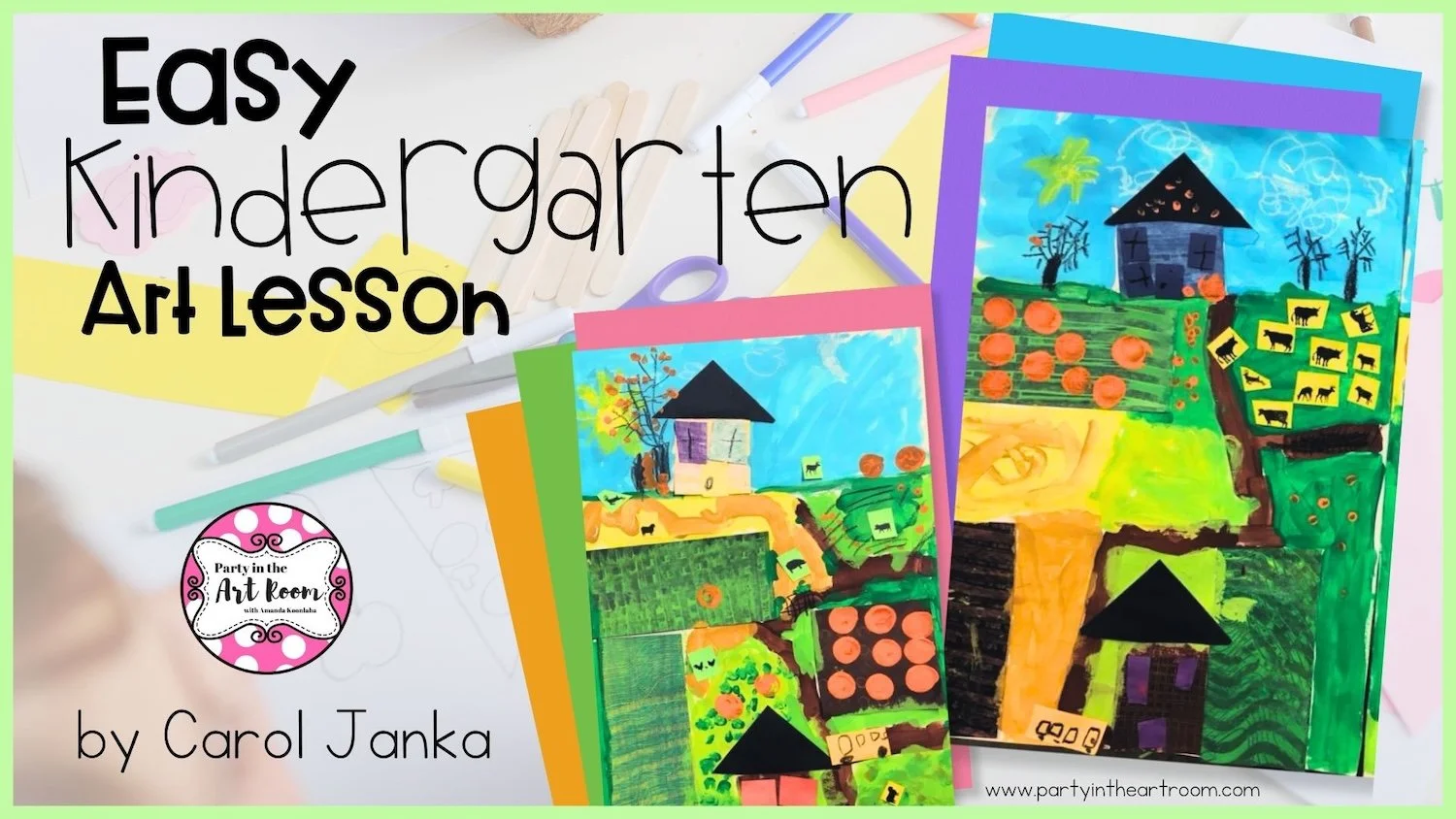How to Teach Depth to Kindergarten: Easy Art Lesson
Carol Janka, an all-around-lovely human being and wonderful art teacher, is a cherished friend of Party in the Art Room. In this post, she shares a captivating collage project designed with careful consideration of the elements of visual art and the exploration of 3D space in art.
This kindergarten art lesson has many beautiful steps that touch on an array of visual art skills. From exploring the fundamental elements of visual art to mastering the intricacies of 3D space in art, this kindergarten art project is a treasure trove.
Kindergarten Art Lesson Inspiration
Carol got inspired by another wonderful art teacher, Pamela Holderman, who is also a friend to Party in the Art Room. She had shared some ideas in our Facebook community on how to teach space as one of the elements of visual art to kindergarteners, which Carol thought would work well for her own students.
Carol shared the artwork of Charles Wysocki, putting her own spin on the lesson. She showed the kids some of Wysocki's pieces and got them talking about the elements of visual art.
Throughout the lesson, Carol guided them through discussions and activities, helping them connect the dots between what they're seeing and what they're creating. And by the end, the kids were reflecting on how their understanding of space had grown through all this artistic exploration.
Carol wrote this about her lesson in the post in our community:
Kindergarten mixed media fall landscapes are finished, just in time for winter. Over several art classes, students were introduced to a variety of media and processes. Discussions were related to home, school, field trip to corn maze and pumpkin patch. So, so sweet how they directed themselves to making meaningful lines and shapes.
3 Reasons to Share Wysocki with Kindergarteners
Visual Storytelling: Wysocki's charming and nostalgic artwork often depicts quaint rural scenes, bustling towns, and whimsical characters engaged in everyday activities. These vibrant and detailed paintings serve as visual stories that kindergarteners can easily relate to and engage with. Through Wysocki's work, children can practice observing, interpreting, and narrating stories, fostering their language development and imaginative skills.
Introduction to Americana: Wysocki's artwork often captures the essence of American life, featuring idyllic landscapes, cozy cottages, and nostalgic motifs reminiscent of times past. By exploring his paintings, kindergarteners can gain an appreciation for Americana and cultural heritage, learning about aspects of American history, architecture, and community life in a visually captivating manner. This exposure to different cultural elements fosters curiosity, empathy, and a sense of connection to the world around them.
Exploration of the Elements of Visual Art: Wysocki's distinctive style is characterized by bold colors, intricate patterns, and whimsical details that appeal to young children's sense of wonder and curiosity. By studying Wysocki's use of colors, shapes, and patterns, kindergarteners can develop their visual literacy skills and artistic sensibilities. They can experiment with identifying and recreating colors, shapes, and patterns found in Wysocki's artwork, fostering their creativity and aesthetic appreciation.
5 Steps: Kindergarten Art Project
The learning target for this project was:
“I️ can make art to tell a story.”
Paint the Sky and Land - Draw a horizon line on a sheet of tagboard. Add white crayon clouds and paint a blue watercolor resist. Then, use green tempera or acrylic paint to paint the land.
Make the Home or School - Use tempera or acrylic paint, crayons, and construction paper shapes.
Create the Farm and Fields - Paint another sheet of tagboard with two shades of green. Use texture tools to create lines and patterns. Once dry, cut this paper into smaller rectangles.
Add the Animals and Plants - Use paint dotters or construction paper shapes to create plants. Use animal stamps on construction paper with black in to create the animals. Cut out the animals in rectangles and squares.
Assemble - Arrange all of the pieces, once dry, onto the paper with the sky and land from the first step. Glue all of the pieces in place.
Tempera Versus Acrylic Paint
When considering the media for this project, it's essential to weigh the differences between tempera paint versus acrylic paint. (Learn more about the difference between tempera and acrylic paint here.)
Acrylic paint, known for its vibrant colors and versatility, allows students to create bold, expressive artworks with rich textures and a glossy finish. However, due to its quick drying time and permanent nature once dry, acrylic paint may present challenges for kindergarten art projects. Kindergarteners tend to require more time and flexibility to work with the medium.
In contrast, tempera paint, a staple in elementary art classrooms, offers a forgiving and accessible option for kindergarten art lessons. Made from pigment, water, and a binding agent such as egg yolk or glue, tempera paint dries quickly to a matte finish, allowing students to layer colors and experiment with textures on paper. While tempera paint may not offer the same intensity or permanence as acrylic paint, its ease of use and ability to create nuanced textures make it ideal for this project.
Ultimately, the choice between acrylic vs tempera paint will depend on factors such as the age and skill level of the students, as well as the desired outcome of the project. For this particular kindergarten art project, using tempera paint is recommended for its ability to create dynamic textures on paper while providing a user-friendly experience for young learners.
Collage Art: 3D Space in Art
In this kindergarten art lesson, students explored techniques like overlapping and variation in size to create compositions that convey depth and spatial relationships.
Students discovered how overlapping objects can suggest depth within a composition. By layering elements, students learned that objects placed closer to the viewer partially obscure those behind them, creating the illusion of 3D space in art that is actually flat. They created a sense of depth and distance. This simple technique allows students to visually communicate the spatial relationships between objects in their artwork.
Final Thoughts
Carol says this was
"a blast, and the kids were taught how to use many media and tools to complete work."
This innovative approach empowered students to express themselves with confidence, fostered a deeper appreciation for the role of space as one of the elements of art and equipped them with valuable skills for subsequent art-making.
Level Up This Kindergarten Art Lesson with Cozy Cottages
The sweet little buildings in Carol’s art lesson are reminiscent of Party in the Art Room’s Cozy Cottage Art Lesson for Kids on Teachers Pay Teachers. In fact, this would be a great resource to scaffold Carol’s lesson up for more advanced artists or older students. Students could create the cottage using the
This resource will help you level up your collage artists lessons!
Get this FREE Daffodil Collage Lesson Plan today!









